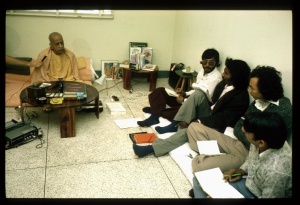SB 4.27.15: Difference between revisions
m (1 revision(s)) |
No edit summary |
||
| Line 1: | Line 1: | ||
{{info | {{info | ||
|speaker= | |speaker=Nārada Muni | ||
|listener=King | |listener=King Prācīnabarhiṣat | ||
}} | }} | ||
[[Category:Srimad-Bhagavatam - Canto 04 Chapter 27]] | |||
[[Category:Bhagavatam Verses Spoken by Narada Muni - Vanisource|042715]] | |||
<div style="float:left">'''[[Srimad-Bhagavatam]] - [[SB 4|Fourth Canto]] - [[SB 4.27: Attack by Candavega on the City of King Puranjana - the Character of Kalakanya|Chapter 27: Attack by Caṇḍavega on the City of King Purañjana - the Character of Kālakanyā]]'''</div> | |||
<div style="float:right">[[File:Go-previous.png|link=SB 4.27.14]] '''[[SB 4.27.14]] - [[SB 4.27.16]]''' [[File:Go-next.png|link=SB 4.27.16]]</div> | |||
{{RandomImage}} | |||
==== TEXT 15 ==== | ==== TEXT 15 ==== | ||
<div | <div class="verse"> | ||
te caṇḍavegānucarāḥ | :te caṇḍavegānucarāḥ | ||
purañjana-puraṁ yadā | :purañjana-puraṁ yadā | ||
hartum ārebhire tatra | :hartum ārebhire tatra | ||
pratyaṣedhat prajāgaraḥ | :pratyaṣedhat prajāgaraḥ | ||
</div> | </div> | ||
| Line 16: | Line 22: | ||
==== SYNONYMS ==== | ==== SYNONYMS ==== | ||
<div | <div class="synonyms"> | ||
''te''—all of them; ''caṇḍavega''—of Caṇḍavega; ''anucarāḥ''—followers; ''purañjana''—of King Purañjana; ''puram''—city; ''yadā''—when; ''hartum''—to plunder; ''ārebhire''—began; ''tatra''—there; ''pratyaṣedhat''—defended; ''prajāgaraḥ''—the big serpent. | |||
</div> | </div> | ||
| Line 23: | Line 29: | ||
==== TRANSLATION ==== | ==== TRANSLATION ==== | ||
<div | <div class="translation"> | ||
When King Gandharva-rāja [Caṇḍavega] and his followers began to plunder the city of Purañjana, a snake with five hoods began to defend the city. | When King Gandharva-rāja [Caṇḍavega] and his followers began to plunder the city of Purañjana, a snake with five hoods began to defend the city. | ||
</div> | </div> | ||
| Line 30: | Line 36: | ||
==== PURPORT ==== | ==== PURPORT ==== | ||
<div | <div class="purport"> | ||
When one is sleeping, the life air remains active in different dreams. The five hoods of the snake indicate that the life air is surrounded by five kinds of air, known as prāṇa, apāna, vyāna, udāna and samāna. When the body is inactive, the prāṇa, or the life air, is active. Up to the age of fifty one can actively work for sense gratification, but after the fiftieth year one's energy decreases, although one can with great strain work for two or three more years—perhaps up to the fifty-fifth year. Thus the fifty-fifth year is generally taken by government regulations as the final year for retirement. The energy, which is fatigued after fifty years, is figuratively described herein as a serpent with five hoods. | When one is sleeping, the life air remains active in different dreams. The five hoods of the snake indicate that the life air is surrounded by five kinds of air, known as ''prāṇa, apāna, vyāna, udāna'' and ''samāna''. When the body is inactive, the ''prāṇa'', or the life air, is active. Up to the age of fifty one can actively work for sense gratification, but after the fiftieth year one's energy decreases, although one can with great strain work for two or three more years—perhaps up to the fifty-fifth year. Thus the fifty-fifth year is generally taken by government regulations as the final year for retirement. The energy, which is fatigued after fifty years, is figuratively described herein as a serpent with five hoods. | ||
</div> | </div> | ||
__NOTOC__ | |||
<div style="float:right; clear:both;">[[File:Go-previous.png|link=SB 4.27.14]] '''[[SB 4.27.14]] - [[SB 4.27.16]]''' [[File:Go-next.png|link=SB 4.27.16]]</div> | |||
__NOTOC__ | |||
__NOEDITSECTION__ | |||
Revision as of 13:56, 30 May 2021

A.C. Bhaktivedanta Swami Prabhupada
TEXT 15
- te caṇḍavegānucarāḥ
- purañjana-puraṁ yadā
- hartum ārebhire tatra
- pratyaṣedhat prajāgaraḥ
SYNONYMS
te—all of them; caṇḍavega—of Caṇḍavega; anucarāḥ—followers; purañjana—of King Purañjana; puram—city; yadā—when; hartum—to plunder; ārebhire—began; tatra—there; pratyaṣedhat—defended; prajāgaraḥ—the big serpent.
TRANSLATION
When King Gandharva-rāja [Caṇḍavega] and his followers began to plunder the city of Purañjana, a snake with five hoods began to defend the city.
PURPORT
When one is sleeping, the life air remains active in different dreams. The five hoods of the snake indicate that the life air is surrounded by five kinds of air, known as prāṇa, apāna, vyāna, udāna and samāna. When the body is inactive, the prāṇa, or the life air, is active. Up to the age of fifty one can actively work for sense gratification, but after the fiftieth year one's energy decreases, although one can with great strain work for two or three more years—perhaps up to the fifty-fifth year. Thus the fifty-fifth year is generally taken by government regulations as the final year for retirement. The energy, which is fatigued after fifty years, is figuratively described herein as a serpent with five hoods.